Paracheirodon axelrodi
Cardinal Tetra
SynonymsTop ↑
Cheirodon axelrodi Schultz, 1956; Hyphessobrycon cardinalis Myers & Weitzman, 1956
Etymology
Paracheirodon: from the Greek para, meaning ‘related to’, and the generic name Cheirodon.
axelrodi: named for author, publisher of pet care books, and entrepreneur Herbert R. Axelrod.
Classification
Order: Characiformes Family: Characidae
Distribution
Type locality is ‘stream near Tomar, Rio Negro, near Porto Velho, Brazil’, although this appears to be erroneous since Porto Velho is located on the rio Madeira and P. axelrodi has never been recorded from that drainage.
Its current confirmed range extends westwards (upriver) from the area around the municipality of Santa Isabel do Rio Negro (formerly Tapuruquara) in the middle rio Negro basin, Brazil, to lower parts of the Ríos Vaupés (aka Uaupés in Brazil), Içana, Guaviare, Inírida, Meta and Vichada.
It also occurs in the Casiquiare Canal and parts of the Orinoco watershed in Venezuela, with the latter populations exhibiting some morphological differences compared with those from the Negro (see ‘Notes’).
Cooke et al. (2009) conducted a phylogeographic analysis of rio Negro populations and found those inhabiting the upper part of the basin to represent genetically distinct lineages of far older origin than those in the middle basin.
As a result six populations from the tributary headwaters Vaupés, Paduá, Marié, Curicuriari, Ferrinha and Tea, respectively, were recommended for conservation priority due to their genetic uniqueness.
Habitat
A more-or-less exclusive inhabitant of forest streams and minor tributaries containing relatively slowly-moving water.
In the rio Negro system it inhabits so-called igapó and igarapé habitats characterised by thick, often overhanging, riparian vegetation and substrates covered in fallen branches, tree roots and leaf litter.
The water is typically acidic, of negligible carbonate hardness and conductivity and stained brownish due to the presence of humic substances released by decomposing organic matter.
In the Orinoco system it’s more commonly-associated with habitats known as morichals which tend to contain transparent, clear water and sandy substrates, often with dense growth of aquatic plants or riparian vegetation among which the fish take shelter.
Although the water is acidic it is less so than in the Negro with typical values of 5.5-6.5.
Both types of habitat are highly-seasonal in nature and during the dry season the fish tend to form large schools in the main stream channels, among the layer of leaf litter and other organic detritus which forms due to the lack of flow.
When the wet season rains begin water depth and flow increases and the streams flood the surrounding terrain.
The leaf litter tends to disperse, exposing the underlying sand, and the fish swim higher in the water column, moving into areas of inundated vegetation or taking cover among submerged roots (Mikolji, 2009).
This seasonal hydrological cycle also permits mixing of cardinal tetra populations that would otherwise remain isolated from one another.
In nature P. axelrodi is considered a virtually annual fish with individuals over a year old rarely-encountered, although it can live considerably longer in aquaria.
It occurs alongside hundreds of other species but some of those occurring in the Río Orinoco and available in the aquarium trade include Corydoras delphax, Platydoras costatus, Baryancistrus beggini, Hypancistrus inspector, Panqolus maccus, Panaque nigrolineatus, Hemigrammus rhodostomus, H. stictus, Hyphessobrycon sweglesi, Pristella maxillaris, Copella nattereri, Biotodoma wavrini, Geophagus dicrozoster, Heros severus, Mesonauta insignis, Satanoperca daemon and Uaru fernandezyepezi, for example.
Maximum Standard Length
20 – 35 mm.
Aquarium SizeTop ↑
An aquarium with base dimensions of 60 ∗ 30 cm or larger is recommended.
Maintenance
Maintenance generally presents few problems although a degree of care is necessary with wild specimens which are more intolerant of deteriorating water conditions than commercially-produced fish.
It perhaps looks best in a heavily-planted set-up or natural-style arrangement comprising a sandy substrate plus some driftwood roots and branches.
The addition of dried leaf litter would further emphasise the natural feel and as well as offering additional cover for the fish brings with it the growth of microbe colonies as decomposition occurs.
These can provide a valuable secondary food source for fry and the humic substances released by the decaying leaves are also considered beneficial, with alder cones also useful in this respect.
There’s no need to use natural peat, the collection of which is both unsustainable and environmentally-destructive.
This species seems to do best under fairly dim lighting but you can add aquatic plant species that can survive under such conditions such as Microsorum, Taxiphyllum or Cryptocoryne spp., while floating vegetation, such as Ceratopteris spp., is also appreciated.
Water Conditions
Temperature: 23 – 29 °C
pH: 3.5 – 7.5 although wild specimens do best in more acidic conditions.
Hardness: 18 – 215 ppm; towards the lower end of this range for wild fish or breeding.
Diet
Likely to be omnivorous feeding on small invertebrates, crustacea, filamentous algae, fallen fruit and suchlike in nature.
In aquaria it may survive on a diet of dried foods but like most fishes does best when offered a varied menu which in this case should also contain live and frozen chironomid larvae (bloodworm), mosquito larvae, Daphnia, Moina, etc.
Behaviour and CompatibilityTop ↑
Generally peaceful making it an ideal resident of the well-researched community aquarium.
It’s perhaps best-maintained alongside similarly-sized characids, gasteropelecids, lebiasinids, smaller callichthyid or loricariid catfishes and non-predatory, small-to-medium-sized cichlids.
Try to buy a mixed-sex group of at least 8-10 specimens, include other schooling fishes to provide security, and you’ll be rewarded with a more natural-looking spectacle.
Sexual Dimorphism
Sexually mature females are noticeably rounder-bodied and a little larger than males.
Reproduction
You’ll need to set up a dedicated tank if you want to raise decent numbers of fry. This should be very dimly lit and contain clumps of fine-leaved plants such as java moss or spawning mops, to give the fish somewhere to deposit their eggs.
Alternatively you could cover the base of the tank with some kind of mesh. This should be of a large enough grade so that the eggs can fall through it, but small enough so that the adults cannot reach them.
The water should be soft and acidic in the range pH 5.5-6.5, gH 1-5, with a temperature of around 80-84°F.
A small air-powered sponge filter bubbling away very gently is all that is needed in terms of filtration.
It can be spawned in a group, with half a dozen specimens of each sex being a good number. Condition these with plenty of small live foods and spawning shouldn’t present too many problems.
The adults can be removed once eggs are noticed, or in a very heavily planted tank left in situ and fry siphoned from the tank as they’re noticed.
In terms of productivity, it’s best spawned in pairs. Under this technique the fish are conditioned in male and female groups in separate tanks, or via the use of a tank divider.
When the females are noticeably full of eggs and the males are displaying their best colours, select the fattest female and best-coloured male and transfer them to the spawning tank in the evening.
They should spawn during the night, often around midnight, have been observed to do so even if the aquarium lights are switched on, and exhibit their night-time colour pattern throughout.
If no eggs have appeared after a couple of days remove them and try a different pair.
In either situation the adults will eat the eggs given the chance and should be removed as soon as eggs are noticed. These will hatch in 24-36 hours, with the fry becoming free swimming a 3-4 days later.
They should be fed on an infusoria–type food for the first few days, until they’re large enough to accept microworm or brine shrimp nauplii.
The eggs and fry are light sensitive in the early stages of life and the tank should be kept in darkness if possible.
NotesTop ↑
This species is immensely popular in the aquarium hobby and is now commercially-bred on a large scale with selectively-produced ornamental strains including ‘gold’ and albino.
It was initially going to be described as Hyphessobrycon cardinalis by Myers and Weitzman (1956) but just before this was due to be published Schultz presented an alternative description in the hobbyist magazine ‘Tropical Fish Hobbyist’ and named the fish after the publication’s founder, Dr. Herbert R. Axelrod.
A significant proportion of the fish available in the aquarium trade are still wild caught or derive from community-led breeding projects such as Project Piaba in the middle Negro region, where this species is the most important ornamental fish and in the municipality of Barcelos accounts for as much as 60% of annual income.
Weitzman and Fink (1983) observed differences in the number of branched pectoral-fin rays, branched anal-fin rays, predorsal scales, and ventral-limb gill rakers between rio Negro and Río Orinoco populations whilst also noting that no conclusions could be drawn due to the need for more extensive collections and sample sizes.
There are also differences in colour pattern. The Rio Negro form possesses a somewhat straighter and longer blue lateral stripe which terminates below the adipose fin base, and usually has the red pigment extending slightly further onto the belly. The Orinoco form has less red pigmentation in the ventral portion of the body, and the blue lateral stripe ends before the adipose fin and is frequently slightly curved in a slight arc shape. These characteristics give the Orinoco form a chunkier appearance than the Negro form.
As in all members of the genus some wild specimens possess a variable number of golden metallic scales and are marketed as P. axelrodi ‘platinum’ or ‘gold’. Although naturally-occurring the condition is said to be caused by a parasite which stimulates increased guanine deposition in the scales.
P. axelrodi can be told apart from its congeners P. innesi and P. simulans by the following combination of characters following Weitzman and Fink (1983): premaxilla with a single row of 5 teeth each having 5 cusps (3 cusps in specimens measuring less than 10 mm SL); maxilla with 1 tooth having 5 cusps; dentary with anterior teeth often having 5, up to 7 cusps; ventral-limb gill rakers 12-14, usually 12-13; pored lateral-line scales 5-8, usually 6-7; red pigmentation on the body of live specimens extending well anterior to the pelvic-fin base.
For aquarists perhaps more useful are the subtle differences in colour pattern with P. axelrodi differing from P. innesi in possessing relatively more red pigment on the body, a broader blue lateral stripe which extends more posteriorly and a less distinct white marking on the anal-fin.
It differs from P. simulans in possessing a bluer (vs. greener) lateral stripe which extends only as far as the adipose-fin (vs. extending to caudal-fin base), a greater amount of red pigment on the flanks and less blue pigment on the eye.
The taxonomic history of all three species is complicated with earlier authors such as Géry (1960, 1977) tending to include them in separate genera as Hypessobrycon simulans, Cheirodon axelrodi and Paracheirodon innesi, respectively, with this classification mostly based on dental morphology following the system proposed by Eigenmann (1915). Others such as Madsen (1975) placed both P. axelrodi and P. simulans in the genus Cheirodon while van Ramshorst (1981) included P. innesi in Cheirodon as well.
Weitzman and Fink (1983) provided the first evidence for the monophyly of Paracheirodon, containing all three species, via a number of osteological characters plus their distinctive colour pattern consisting of an intense blue or blue-green lateral stripe, dense red pigment on the body restricted to the portion ventral to the lateral stripe, and a stripe of dark brown or black chromatophores underlying and extending dorsally to the lateral stripe.
A fourth “neon” species was discovered by Heiko Bleher in 2006 at a single locality, a nameless igarape within the rio Purus system, the main channel of which enters the Amazon upstream of the rio Negro. The fish has to date not been described, but DNA sequencing by Axel Meyer on the few specimens recovered apparently indicates that the newly discovered species is genetically closest to P. inessi (Bleher, 2008).
The closer relationships of Paracheirodon within the family Characidae have not yet been fully-confirmed with the grouping considered incertae sedis by the majority of recent authors.
Results obtained in the molecular phylogenetic analysis of Oliveira et al. (2011) recovered P. axelrodi to be most-closely related to certain members of Hyphessobrycon species (specifically H. eques and H. megalopterus) among those species included in the study.
The function of the intense blue lateral stripe in Paracheirodon spp. may have evolved as a predator evasion strategy according to the hypothesis of Ikeda and Kohshima (2009) which was published following direct field study of the fish in blackwater streams near Requena in the Peruvian Amazon plus observation of wild specimens in aquaria under different conditions.
The reserachers found that the bright colouration of the lateral stripe in P. innesi is less conspicuous in blackwater except when viewed from a limited angle of around 30° above the horizon, and that this could aid in confusing predators via bright mirror images of the stripe being projected onto the underside of the water surface.
Whereas most characids displaying a laterally-striped colour pattern possess a dark-coloured lateral stripe with a lighter stripe dorsally, this pattern is reversed in Paracheirodon and may be an adaptation for forming such mirror images.
The fish are also able to change the intensity of their overall colour pattern to an extent, becoming lighter in bright conditions with pale substrate or background and clear water, and duller with a violet lateral stripe at night, and this may also be a response designed to make them less visible.
References
- Bleher, Heiko, 2008 - Tropical Fish Hobbyist, October 2008: 92-95
A Story of Four Neon Tetras, Part Two: And Now a Fourth Neon! - Cooke, G. M., N. L. Chao and L. B. Beheregaray, 2009 - Freshwater Biology 54: 1216–1232
Phylogeography of a flooded forest specialist fish from central Amazonia based on intron DNA: the cardinal tetra Paracheirodon axelrodi. - Géry, J., 1977 - T.F.H. Publications, Inc.: 1-672
Characoids of the World. - Ikeda, T. and S. Kohshima, 2009 - Environmental Biology of Fishes 86: 427-441
Why is the neon tetra so bright? Coloration for mirror-image projection to confuse predators? “Mirror-image decoy” hypothesis. - Mikolji, I., 2009 - Tropical Fish Hobbyist 635: 70-75
Cardinal tetras in their natural nabitat. - Oliveira, C. A., G. S. Avellino, K. T. Abe, T. C. Mariguela, R. C. Benine, G. Orti, R. P. Vari, and R. M. Corrêa e Castro, 2011 - BMC Evolutionary Biology 11(1): 275-300
Phylogenetic relationships within the speciose family Characidae (Teleostei: Ostariophysi: Characiformes) based on multilocus analysis and extensive ingroup sampling. - Reis, R. E., S. O. Kullander and C. J. Ferraris, Jr. (eds), 2003 - EDIPUCRS, Porto Alegre: i-xi + 1-729
Check list of the freshwater fishes of South and Central America. CLOFFSCA. - Weitzman, S. H. and W. L. Fink, 1983 - Bulletin of the Museum of Comparative Zoology 150(6): 339-395
Relationships of the neon tetras, a group of South American fishes (Teleostei, Characidae), with comments on the phylogeny of New World characiforms.
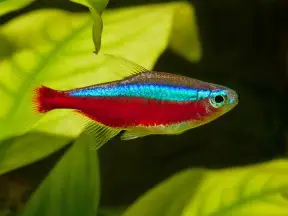

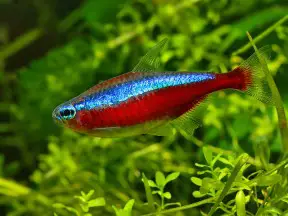
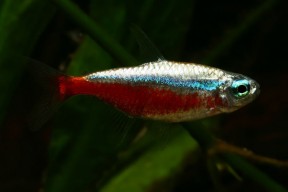
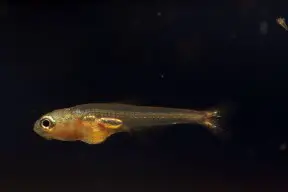
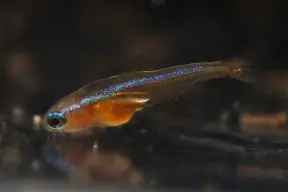
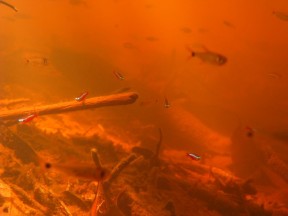

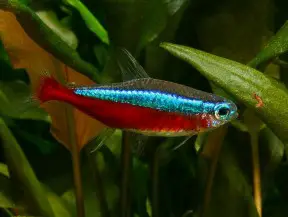
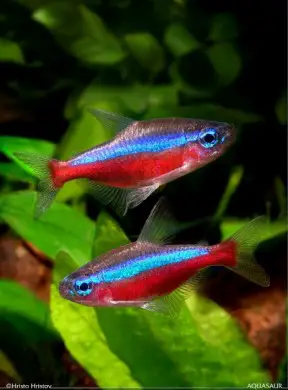
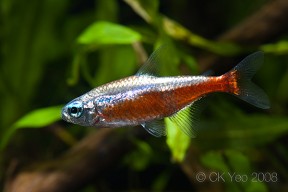
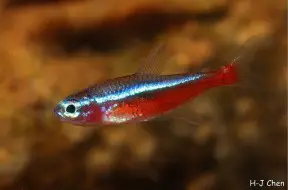
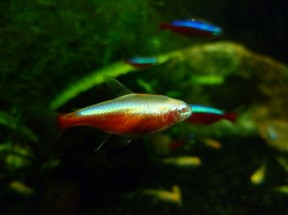
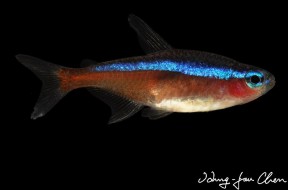



November 19th, 2012 at 7:51 am
Found this article very interesting and useful.
I have learned the hard way that Siamese Fighters [M & F] do not mix well with this fish, so do bear that in mind when choosing new tank mates for this beautiful fish.
March 9th, 2013 at 4:08 pm
Actually, in my experience they do quite well. I’ve had a tank going with ten P. Axelrodi and one male B. Splendens for about eight months now without incident.
April 16th, 2013 at 12:54 am
Correction re spawning: Cardinals are night spawners. I’ve observed group spawnings which normally take place around midnight. Interestingly, this will take place even if the aquarium lights are switched on. The fish also exhibit their ‘night time’ colour pattern even if the aquarium is lit during spawning.
Paul
April 17th, 2013 at 10:23 am
Hi Paul, thanks for the info, I’ve changed that part now. Is the rest of the breeding section ok?
April 18th, 2013 at 9:24 am
Hi Matt – posted a reply yesterday but it didn’t appear. Anyway, try again:
breeding info seems okay now. I do however, believe that Cardinals are seasonal spawners (Jan – Feb). I also suspect that breeders in the Czech Republic use hormones to regulate / contol spawinings?
Males also have VERY flat stomachs (almost like a straight line). The pic above looks like a female to me. Also I would not choose the fattest females for spawning as there may be problems with them being ‘egg-bound’. This is certainly the case with the common Neon, which unlike the Cardinal, which is very prolific and breeds all year round.
June 19th, 2013 at 8:52 pm
I’ve seen Cardinal tetras as big as mine Parosphromenus with my own two eyes. They were ca 4-5cm long.
June 21st, 2013 at 11:54 am
Hi Sverting is that standard length (SL) or total length (TL)? In the profiles we use the former.
June 29th, 2013 at 2:48 pm
I’m not counting the tail. They were MUCH bigger than adult P. innesi.
January 26th, 2016 at 3:42 pm
According to this research: http://www.scielo.br/pdf/aa/v38n4/v38n4a23.pdf you will have a mortality rate between 17 and 30% if you keep these fish on the lowest temperature mentioned in this article? I would suggest safe temperatures ranging from 23 to 29 degrees celsius.
January 26th, 2016 at 4:10 pm
Thanks for the input, this has now been updated.
July 20th, 2019 at 7:48 am
Thanks SF, this article with all the additional comments/responses, has given a total insight bout the P.axelrodi.
Cheers !